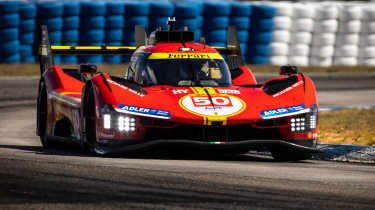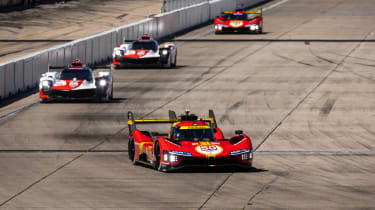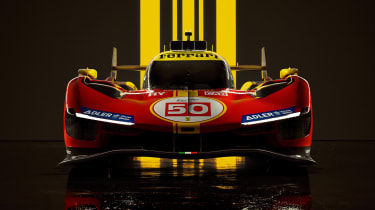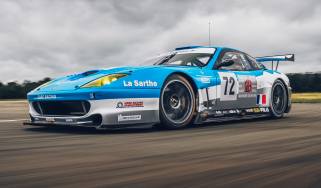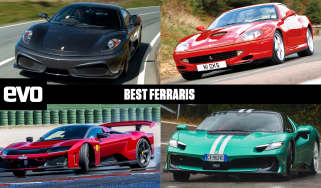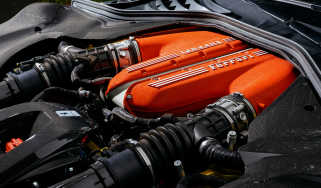Ferrari 499P Le Mans Hypercar – Maranello returns to endurance racing
After a gap of 50 years, Ferrari has returned to the endurance racing fray – and is straight on the pace
I’m not sure you can declare any period of racing a ‘golden era’ before it’s really begun, but that hasn’t stopped sportscar fans, championship organisers and manufacturers daring to utter those words about the new Hypercar class for the World Endurance Championship and Le Mans 24 Hours. After the rise and the inevitable, crashing fall of the heinously expensive LMP1 category, a new set of rules – shared between IMSA in the US and WEC/Le Mans – has brought in new players, new shapes, new sounds and paved the way for the return of iconic marques.
Porsche is back. Cadillac has arrived. BMW is already racing in the US alongside Acura and will be at Le Mans in 2024, joined by Lamborghini. There are more, too. Toyota, Peugeot, Alpine for ’24, Glickenhaus, Vanwall. At the 100th running of Le Mans, there will be seven manufacturers and a top class consisting of 16 cars. And this is just the start. For 2024 it’s conceivable there could be 30 top-level cars. It’s a world away from the recent hegemony by Toyota, racing against minnows or older, less sophisticated machinery and strolling to victory.
> 2023 WEC and IMSA seasons ready for launch – Le Mans Hypercar and LMDh contenders
Yet at the 1000 miles of Sebring, the first round of this year’s WEC season, it’s as though there is only one story. Ferrari. After a 50-year absence, the red cars are back on the world stage in top-level endurance racing. Never mind that the Ferraris are tucked away at the far end of the paddock and the team’s footprint is notably more understated than the huge presence created by the Porsche and Toyota hospitality units. Every time I walk past, there’s a throng of people around the pair of 499P Hypercars. After qualifying the throng becomes a stampede. The number 50 Ferrari of Antonio Fuoco, Miguel Molina and Nicklas Nielsen is on pole. Even the team seem a little disbelieving.
‘If I need to be honest, on the last corner I just send it,’ says a wide-eyed Fuoco after his stunning pole lap. Qualifying at Sebring takes place as the sun sets and it’s dazzlingly low. Visibility is a real issue, but not enough to stop this fairytale playing out. ‘I had some reference points from free practice, so just used them. I had a big moment on the bumps also. But you could say we put it all together and showed our potential. It felt quite OK in general.’ Fuoco, who was Charles Leclerc’s teammate in F2, appears to be a master of understatement.
If driver and Ferrari team members in general look a little dazed and rightly elated, the rivals are closer to a state of genuine shock. Toyota, who had dominated practice and oozed confidence beforehand, look a bit lost. Their number 8 and number 7 cars line up 2nd and 3rd with the sister Ferrari, 51, in 4th ahead of the sole Cadillac and the Porsches a distant 6th and 7th. Would Porsche be in better shape for the race, I asked a senior team member. ‘Erm… no. We don’t think so.’ Their anonymous weekend could scarcely be a bigger contrast to the buoyant Ferrari.
At this point it’s worth revisiting the new Hypercar class and the two sorts of vehicles eligible to enter. The ‘pure’ Hypercars are called LMH (Le Mans Hypercar, fittingly enough) and feature bespoke prototype architecture or are road car-derived. LMH entries can be hybrid or pure ICE. They provide a great deal of technical freedom but still have to fit into a tightly defined performance window. Toyota, Peugeot, Ferrari, Glickenhaus and Vanwall are all built to LMH regulations. These cars are more expensive to produce but allow more proprietary technology and the hybrid versions can deploy through the front wheels for four-wheel-drive capability. Currently LMH cars can only race in WEC and at Le Mans.
The LMDh cars (Le Mans Daytona Hybrid) provide a simpler, cheaper solution to racing at the top level and are also eligible for the hugely popular IMSA series in the US. There is free choice in terms of engine configuration but manufacturers can choose from four approved chassis suppliers – Dallara, Oreca, Ligier and Multimatic – and there is a spec hybrid system comprising Bosch electric motor integrated into an XTrac seven-speed gearbox and a Williams Advanced Technology battery pack. The e-motor delivers just 67bhp to the rear wheels exclusively. Both LMH and LMDh have a minimum weight of 1030kg and power is around 670bhp depending on the calculated Balance of Performance. Porsche, Cadillac, BMW, Lamborghini and Acura are built to LMDh rules.
This split formula sounds confusing but it does provide huge technical intrigue and, hopefully, some very close racing. For example, the Toyota GR010 HYBRID uses a 3.5-litre twin-turbocharged V6 capable of over 700bhp plus a front motor system capable of producing 268bhp. Yet it has to blend these two power sources to deliver its allowed maximum, which is set at 693bhp for Sebring. Plus, it can’t deploy the electrical power until a minimum speed of 190kph. So whilst four-wheel drive sounds appealing, the reality is that the traction advantages are negated by the high deployment speed. In short you’re carrying a lot of weight for not a lot of advantage. On the other hand, tyre management should be easier as you can give those rears a breather as power to the fronts is activated.
By contrast, the Cadillac LMDh car has a thunderous and brand new naturally aspirated 5.5-litre V8 that revs to 8800rpm; Peugeot has gone for a 2.6-litre twin-turbo V6 and uses underbody aero instead of the intricate rear wings of rivals, Porsche has a 4.6-litre twin-turbo V8, and so the list goes on. Nobody has a V10 or V12 just yet, but we can hope. And it would be allowed. Sadly, Ferrari hasn’t lifted the engine from the 812 Competizione then, but its 3-litre wide-angle twin-turbo V6 is derived from that of the 296 GTB and 296 GT3. Like the Toyota, the Ferrari has a 268bhp e-motor driving the front wheels at speeds of over 190kph.
Qualifying is a raw demonstration of the 499P’s one-lap pace and the dream headline for Ferrari, WEC and Le Mans. Perhaps unsurprisingly, the race is a different story. Ferrari cede the lead to Toyota by pitting during an early safety car period and never gain it back. In fact, the Toyota is comfortably quicker than the Ferrari on race pace and the team look well-drilled and absolutely on top of tactics. Experience tells and, although the 499P looks convincing, an absence of 50 years can’t be made up in one race. Ferrari need to sharpen up, get to know their new car intimately and operate at the highest level if they want to catch and pass the formidable Toyota Gazoo Racing machine.
However, as Ferrari slip back towards Cadillac and Porsche, a real fight ignites. Seeing Molina in the 499P racing wheel-to-wheel with Kévin Estre in one of the 963s, then later his young teammate Nielsen putting a move on André Lotterer is a tantalising glimpse of what this Hypercar class can deliver. It demonstrates the grit of Ferrari’s youthful driver line-up, too. The sister car of James Calado, Alessandro Pier Guidi and Antonio Giovanazzi is similarly rapid. It qualifies 4th and is in contention for a podium finish until Guidi is involved in a collision with two of the GTE-Am cars. The Ferrari team, AF Corse, repair the car and it finishes in 15th place and some 11 laps behind the winning Toyotas. The drivers are disappointed but see the potential of 499P and you sense they’ve realised just how exciting the season ahead could be. Calado sums it up perfectly. ‘It’s been a challenging time at Sebring but the car is fast, the team has done an amazing job and we can get there.’
Fuoco is back in no.50 for the final stint. The challenge from Porsche has faded and although the Cadillac is charging they’ve left themselves too much to do. The Toyotas are long gone in 1st and 2nd, but after 50 years Ferrari is back in the top class of endurance racing and back on the podium. From the outside, Ferrari and AF Corse have appeared to work quietly, efficiently and with no real distraction from the noise and excitement all around them. The drivers all talk about ‘the team’, and there seems to be real pride over the 499P project. Belief, too.
‘It was a challenging race, as we expected, but ultimately, we made it onto the podium and enjoyed some big thrills,’ says Molina. ‘Crossing the finish line with the two Hypercars was an excellent achievement for the entire team, which has worked intensively over recent months. We know we have room for improvement, which we will address with humility and determination.’ For once the words ring true. On the evidence of the 1000 Miles of Sebring, the new golden era will materialise. And Ferrari is likely to be right at the sharp end.
This story was first featured in evo issue 309.
Ferrari 499P specs
The LMh-class 499P is built upon a completely bespoke carbonfibre monocoque, with its hybrid powertrain also unique. Powering the front axle is a single electric motor capable of delivering a peak of 268bhp, drawing power from a 900V battery pack developed using technology derived from its hybrid Formula 1 cars.
Ferrari revealed that it considered the use of V12 and V8 power plants at the project’s inception, but the need to keep weight as low as possible, it settled on a bespoke 120-degree 3-litre twin-turbocharged V6 (499 being the displacement of each cylinder). As per the regulations it produces a maximum of 671bhp, and although it shares architecture with the V6 from the 296 GT3, it doesn’t share any specific parts.
Both the combustion engine and electric motor produce the maximum output allowed under LMh regulations, but to ensure LMh and LMDh cars are competitive with one another, those peak outputs are constantly adjusted to ensure the 499P’s combined output doesn’t exceed 671bhp (500KW).
The braking package is a brake-by-wire Brembo system, chosen for its ability to recover energy from the front axle to charge the hybrid system on the move. As you’d expect, it utilises double wishbone pushrod-type suspension, and in order to help meet the target weight figure (regulations stipulate a 1030kg minimum), Ferrari has made the engine and seven speed sequential transmission both stressed members of the 499P’s chassis.
Appropriately inspired by the 1973 312 P with its red and yellow livery, the 499P adopts a more traditional aero design in comparison to the Peugeot 9X8, with an aggressive rear wing and a central strake that grows from a fin mounted atop a large, rectangular intake snorkel which supplies fresh air to the engine intake, battery and transmission. Underneath the high-mounted wing sits another horizontal plane that extends beyond the rear diffuser, outlined by a full-width light bar.
Elements such as the completely open front arches are made possible by the added freedom of the Le Mans Hypercar program, something that was previously impossible to accomplish under LMP1 regulations. The rear haunches also feature unique bare-carbon humps atop the arches, combining to make it a distinctive design out on the circuit.
> Ferrari 296 GT3 makes public debut at Imola Circuit

